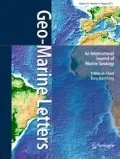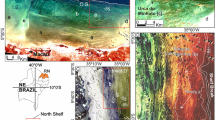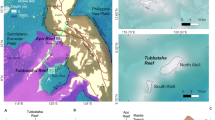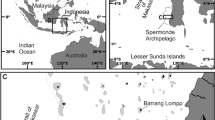Abstract
In mixed terrigenous-carbonate shelves, terrigenous sediment input may influence changes in slope morphology and sedimentation. Moreover, sea level changes and antecedent geology can also play an important role in defining depositional patterns for the shelf-slope system. This work investigates contrasting depositional and geomorphological patterns in the Abrolhos shelf-slope system, eastern Brazilian margin, South Atlantic. We have combined existing bathymetric datasets with bottom imagery and samples collected at the Johnson-Sea-Link manned submersible along two Abrolhos slope sites, which are separated by almost 2° of latitude. Our dataset includes seafloor sediments, single-beam echosounder, and 20 h of video recording. Dives ranged from 90 to 620 m water depth. Results showed that the north and south Abrolhos shelf-slope systems are distinct in terms of their morphology and sedimentology. The depositional pattern in the northern upper slope is typically carbonate dominated, with the occurrence of carbonate mounds around 500 m deep, small biogenic structures around 200 m deep, interspersed with wackstones and packstones. The upper slope is characterized by a steep limestone wall at 120 m deep that resembles a shelf-edge reef, followed by extensive rhodolith beds at the shelf edge and outer shelf. The southern upper slope shows a sigmoidal profile with a gentle gradient. Mixed siliciclastic–carbonate fine sedimentation dominates from 300 to 700 m deep. On the upper slope, fine carbonate sedimentation predominates, and a biogenic reef structure is observed in a water depth around 120–130 m. The shelf edge and outer shelf are also characterized by extensive rhodolith beds. Main findings indicate that a volcanic rock complex is an important antecedent geology that may influence the setting up of distinct sedimentary regimes and sediment input to the slope. The geometry of the antecedent geology controls the paleotopography forming a gradient towards the south. This, combined with sea-level changes and Rio Doce riverine sediment input, can explain the contrasts between the northern and southern shelf-upper slope depositional settings. Here, for the first time, the presence of possible Last Glacial Maximum or early deglaciation stage shelf-edge reef systems is reported for the Abrolhos Bank.











Similar content being viewed by others
References
Adams EW, Kenter JA (2014) So different, yet so similar: comparing and contrasting siliciclastic and carbonate slopes. In: KlaasVerwer TEP, Harris PM (eds) Deposits, architecture and controls of carbonate margin, slope and basinal settings. SEPM Special Publication, Tulsa, Oklahoma, USA, pp 14–25
Aguiar AL, Cirano M, Pereira J, Marta-Almeida M (2014) Upwelling processes along a western boundary current in the Abrolhos–Campos region of Brazil. Cont Shelf Res 85:42–59. https://doi.org/10.1016/j.csr.2014.04.013
Alves TM (2010) 3D seismic examples of differential compaction in mass-transport deposits and their effect on post-failure strata. Mar Geol 271:212–224
Alves TM, Cartwright J, Davies RJ (2009) Faulting of salt-withdrawal basins during early halokinesis: effects on the Paleogene Rio Doce Canyon system (Espírito Santo Basin, Brazil). AAPG Bull 93:617–652
Amado Filho GM, Moura RLD, Bastos AC, Salgado LT, Sumida PYG, Guth AZ, Francini Filho RB, Pereira Filho GH, Abrantes DP, Brasileiro PS (2012) Rhodolith beds are major CaCO 3 bio-factories in the tropical south West Atlantic. In: PloS ONE, p e35171
Arruda WZ, Campos EJD, Zharkov V, Soutelino RG, da Silveira ICA (2013) Events of equatorward translation of the Vitoria Eddy. Cont Shelf Res 70:61–73
Bastos AC, Moura RLD, Amado Filho GM, D’Agostini DP, Secchin NA, Francini-Filho RB, Güth AZ, Sumida PYG, Mahiques MM, Thompson FL (2013) Buracas: novel and unusual sinkhole-like features in the Abrolhos Bank. Cont Shelf Res 70:118–125
Bastos AC, Quaresma VS, Marangoni MB, D’Agostini DP, Bourguignon SN, Cetto PH, Silva AE, Amado Filho GM, Moura RL, Collins M (2015) Shelf morphology as an indicator of sedimentary regimes: a synthesis from a mixed siliciclastic–carbonate shelf on the eastern Brazilian margin. J S Am Earth Sci 63:125–136
Bastos AC, Amado Filho GM, Moura RLD, Sampaio FM, Bassi D, Braga JC (2016) Origin and sedimentary evolution of sinkholes (buracas) in the Abrolhos continental shelf, Brazil. Palaeogeogr Palaeoclimatol Palaeoecol 462:101–111
Beaman RJ, Webster JM, Wust RAJ (2008) New evidence for drowned shelf edge reefs in the Great Barrier Reef, Australia. Mar Geol 247:17–34
Boltovskoy E, Giussiani G, Watanabe S, Wright R (1980) Atlas of Benthic Shelf Foraminifera of the Southwest Atlantic. Junk, The Hague, p 147
Bosence D (2005) A genetic classification of carbonate platforms based on their basinal and tectonic settings in the Cenozoic. Sediment Geol 175:49–72. https://doi.org/10.1016/j.sedgeo.2004.12.030
Castro BM, Dottori M, Pereira AF (2013) Subinertial and tidal currents on the Abrolhos Bank shelf. Cont Shelf Res 70:3–12
Cushman JA (1931) The foraminifera of the Atlantic Ocean, Part 8. Smithsonian Institution, US National Museum, Bulletin 104. Reprint Antiquariaat Junk, Lochem, p 179
D’Agostini DP (2017) A Plataforma continental de Abrolhos: Contexto Paleoambiental, sismoestratigrafia e domínios sedimentares. In: Programa de Pós-Graduação em Oceanografia Ambiental, Doctors Degree Thesis. Universidade Federal do Espírito Santo, Vitória, p 139
D’Agostini DP, Bastos AC, Dos Reis AT (2015) The modern mixed carbonate–siliciclastic Abrolhos shelf: implications for a mixed depositional model. J Sediment Res 85:124–139
Debenay (2013) A guide to 1,000 foraminifera from southwestern Pacific New Caledonia. ISBN IRD 978-2-7099-1729-2, ISBN MNHN 978-2-85653-698-8, p 384
Dominguez JML, da Silva Pinto Bittencourt AC, Martin L (1992) Controls on Quaternary coastal evolution of the east-northeastern coast of Brazil: roles of sea-level history, trade winds and climate. Sediment Geol 80:213–232
Droxler AW, Jorry SJ (2013) Deglacial origin of barrier reefs along low-latitude mixed siliciclastic and carbonate continental shelf edges. Annu Rev Mar Sci 5:165–190
Droxler AW, Schlager W (1985) Glacial versus interglacial sedimentation rates and turbidite frequency in the Bahamas. Geology 13:799–802
Dunham RJ (1962) Classification of carbonate rocks according to depositional textures. AAPG Special M1:108–121
Ellis BF, Messina AR (1940-et sequences) Catalogue on Foraminifera. The Micropalentology Project. Accessed in http://www.micropress.org.
Fiduk JC, Brush ER, Anderson LE, Gibbs PB, Rowan MG (2004) Salt deformation, magmatism, and hydrocarbon prospectivity in the Espirito Santo Basin, offshore Brazil. In: Salt-sediment interactions and hydrocarbon prospectivity: concepts, applications, and case studies for the 21st century: Houston, Gulf Coast Section Society of Economic Paleontologists and Mineralogists, 24th Annual Research Conference, pp 370-392
Flügel E (1982) Microfacies analysis of limestones. Springer Science & Business Media, New York
Foster MS (2001) Rhodoliths: between rocks and soft places. J Phycol 37:659–667
França RL, Del Rey AC, Tagliari CV, Brandão JR, Fontanelli PR (2007) Bacia do Espírito Santo. Boletim de Geociencias da PETROBRAS 15:501–509
Francis JM, Dunbar GB, Dickens GR, Sutherland IA, Droxler AW (2007) Siliciclastic sediment across the North Queensland margin (Australia): a Holocene perspective on reciprocal versus coeval deposition in tropical mixed siliciclastic–carbonate systems. J Sediment Res 77:572–586
Gamboa D, Alves TM (2015) Spatial and dimensional relationships of submarine slope architectural elements: a seismic-scale analysis from the Espírito Santo Basin (SE Brazil). Mar Pet Geol 64:43–57
Gamboa D, Alves TM, Cartwright J (2012) A submarine channel confluence classification for topographically confined slopes. Mar Pet Geol 35:176–189
Ghisolfi RD, da Silva MP, dos Santos FT, Servino RN, Cirano M, Thompson FL (2015) Physical forcing mechanisms controlling the variability of chlorophyll-a over the Royal-Charlotte and Abrolhos Banks—eastern Brazilian shelf. PLoS One 10:e0117082. https://doi.org/10.1371/journal.pone.0117082
Hallock P (2000) Larger foraminifera as indicators of coral-reef vitality. In: Martin RE (ed) Environmental micropaleontology: the application of microfossils to environmental geology. Springer US, New York, pp 121–150
Harris PT, Baker EK (2012) Seafloor geomorphology as benthic habitat: GeoHab Atlas of seafloor geomorphic features and benthic habitats. Elsevier
Henriet J-P, Hamoumi N, Da Silva A-C, Foubert A, Lauridsen BW, Rüggeberg A, Van Rooij D (2014) Carbonate mounds: from paradox to world heritage. Mar Geol 352:89–110
Hinestrosa G, Webster JM, Beaman RJ (2016) Postglacial sediment deposition along a mixed carbonate-siliciclastic margin: new constraints from the drowned shelf-edge reefs of the Great Barrier Reef, Australia. Palaeogeogr Palaeoclimatol Palaeoecol 446:168–185. https://doi.org/10.1016/j.palaeo.2016.01.023
Hovland M, Croker PF, Martin M (1994) Fault-associated seabed mounds (carbonate knolls?) off western Ireland and north-west Australia. Mar Pet Geol 11:232–246
Imbrie J, Hays JD, Martinson DG, McIntyre A, Mix AC, Morley JJ, Pisias NG, Prell WL, Shackleton NJ (1984) The orbital theory of Pleistocene climate: support from a revised chronology of the marine d18O record
Jo A, Eberli GP, Grasmueck M (2015) Margin collapse and slope failure along southwestern Great Bahama Bank. Sediment Geol 317:43–52
Kaiho K (1991) Global changes of Paleogene aerobic/anaerobic benthic foraminifera and deep-sea circulation. Palaeogeogr Palaeoclimatol Palaeoecol 83:65–85
Lambeck K, Rouby H, Purcell A, Sun Y, Sambridge M (2014) Sea level and global ice volumes from the Last Glacial Maximum to the Holocene. Proc Natl Acad Sci 111:15296–15303
Leão ZMDAN, Ginsburg R (1997) Living reefs surrounded by siliciclastic sediments: the Abrolhos coastal reefs, Bahia Brazil. Proceedings of the International Coral Reef Symposium 8:1767–1772
Leão ZMDAN, Kikuchi RKPD, Testa V (2003) Corals and coral reefs of Brazil. In: Cortés J (ed) Latin American coral reefs. Elsevier, Amsterdam, pp 9–52
Li X, Li X, Zhao Q, Liu L, Zhou S (2015) The occurrence, acoustic characteristics, and significance of submerged reefs on the continental shelf edge and upper slope, northern South China Sea. Cont Shelf Res 100:11–24
Loeblich AR, Tappan H (1988) Foraminiferal genera and their classification. Van Nostrand Reinhold Ed, 970 p, 847 est
Martins TR (2014) A Corrente do Brasil no Embaiamento de Tubarão - Oceano Atlântico Sudoeste. In: Programa de Pós-Graduação em Oceanografia Ambiental. Universidade Federal do Espírito Santo, Vitória, p 95
McIlreath IA, James NP (1978) Facies models 13. Carbonate slopes. Geosci Can 5:189–199
Melo UD, Summerhayes CP, Ellis JP (1975) Upper continental margin sedimentation off Brazil, part IV: Salvador to Vitoria, southeastern Brazil. Contrib Sedimentol 4:78–116
Moura RLD, Secchin NA, Amado Filho GM, Francini Filho RB, Freitas MO, Minte-Vera CV, Teixeira JB, Thompson FL, Dutra GF, PYG S (2013) Spatial patterns of benthic megahabitats and conservation planning in the Abrolhos Bank. Cont Shelf Res 70:109–117
Moura RL, Amado-Filho GM, Moraes FC, Brasileiro PS, Salomon PS, Mahiques MM, Bastos AC, Almeida MG, Silva JM, Araujo BF (2016) An extensive reef system at the Amazon River mouth. Sci Adv 2:e1501252
Nalin R, Nelson CS, Basso D, Massari F (2008) Rhodolith-bearing limestones as transgressive marker beds: fossil and modern examples from North Island, New Zealand. Sedimentology 55:249–274
Oliveira KSS, Quaresma VS (2017) Temporal variability in the suspended sediment load and streamflow of the Doce River. J S Am Earth Sci 78:101–115
Page MC, Dickens GR, Dunbar GB (2003) Tropical view of Quaternary sequence stratigraphy: siliciclastic accumulation on slopes east of the Great Barrier Reef since the Last Glacial Maximum. Geology 31:1013–1016
Palóczy A, Brink KH, da Silveira ICA, Arruda WZ, Martins RP (2016) Pathways and mechanisms of offshore water intrusions on the Espírito Santo Basin shelf (18° S–22° S, Brazil). J Geophys Res Oceans 121:5134–5163. https://doi.org/10.1002/2015JC011468
Pomar L (2001) Types of carbonate platforms: a genetic approach. Basin Res 13:313–334
Puga-Bernabéu Á, Webster JM, Beaman RJ, Guilbaud V (2013) Variation in canyon morphology on the Great Barrier Reef margin, north-eastern Australia: the influence of slope and barrier reefs. Geomorphology 191:35–50
Qin Y, Alves TM, Constantine J, Gamboa D (2016) Quantitative seismic geomorphology of a submarine channel system in SE Brazil (Espirito Santo Basin): scale comparison with other submarine channel systems. Mar Pet Geol 78:455–473
Qin Y, Alves TM, Constantine J, Gamboa D (2017) The role of mass wasting in the progressive development of submarine channels Espirito Santo Basin, SE Brazil. J Sediment Res 87:500–516
Rabineau M, Berné S, Olivet J-L, Aslanian D, Guillocheau F, Joseph P (2006) Paleo sea levels reconsidered from direct observation of paleoshoreline position during Glacial Maxima (for the last 500,000 yr). Earth Planet Sci Lett 252:119–137. https://doi.org/10.1016/j.epsl.2006.09.033
Rankey EC, Doolittle DF (2012) Geomorphology of carbonate platform-marginal uppermost slopes: insights from a Holocene analogue, Little Bahama Bank, Bahamas. Sedimentology 59:2146–2171
Schlager W (2005) Carbonate sedimentology and sequence stratigraphy. SEPM Soc for Sed Geology SEPM Society for Sedimentary Geology, Tulsa, Oklahoma, U.S.A
Schlager W, Adams EW (2001) Model for the sigmoidal curvature of submarine slopes. Geology 29:883–886
Schlager W, Camber O (1986) Submarine slope angles, drowning unconformities, and self-erosion of limestone escarpments. Geology 14:762–765
Schmid C, Schäfer H, Zenk W, Podestá G (1995) The Vitória Eddy and its relation to the Brazil Current. J Phys Oceanogr 25:2532–2546
Schreiner S, de Souza MBFM, Migliorelli JPR (2009) Modelo digital da geomorfologia do fundo oceânico do centro-sul da Bacia do Espírito Santo e norte da Bacia de Campos. Boletim de Geociências da Petrobras 17:365–369
Sobreira JFF, França RL (2006) Um modelo tectono-magmático para a região do Complexo Vulcânico de Abrolhos. Boletim de Geociências da PETROBRAS 14:143–147
Soutelino RG, Silveira, ICA, Gangopadhyay AAMJ, Miranda JA (2011) Is the Brazil Current eddy-dominated to the north of 20 S? In: Geophysical Research Letters, p L03607
Soutelino RG, Gangopadhyay A, Silveira ICAD (2013) The roles of vertical shear and topography on the eddy formation near the site of origin of the Brazil Current. Cont Shelf Res 70:46–60. https://doi.org/10.1016/j.csr.2013.10.001
Steller DL, Foster MS (1995) Environmental factors influencing distribution and morphology of rhodoliths in Bahía Concepción, BCS, México. J Exp Mar Biol Ecol 194:201–212
Stramma L, England M (1999) On the water masses and mean circulation of the South Atlantic Ocean. J Geophys Res Oceans 104:20863–20833
Sumida PYG, Yoshinaga MY, Madureira LAS-P, Hovland M (2004) Seabed pockmarks associated with deepwater corals off SE Brazilian continental slope, Santos Basin. Mar Geol 207:159–167
Tucker M (1988) Techniques in sedimentology. Blackwell Scientific, Oxford
Viana AR, de Almeida W, de Almeida CW (2002) Upper slope sands: late Quaternary shallow-water sandy contourities of Campos Basin, SW Atlantic Margin. Geol Soc Lond Mem 22:261–270
Vicalvi MA, Costa MPDA, Kowsmann RO (1978) Depressão de Abrolhos: uma paleolaguna holocênica na plataforma continental leste brasileira. Boletim Técnico da PETROBRÁS 21:279–286
Vilela CG (2003) Taphonomy of benthic foraminiferal tests of the Amazon shelf. J Foraminifer Res 33:132–143
Webster JM, Beaman RJ, Puga-Bernabéu Á, Ludman D, Renema W, Wust RAJ, George NPJ, Reimer PJ, Jacobsen GE, Moss P (2012) Late Pleistocene history of turbidite sedimentation in a submarine canyon off the northern Great Barrier Reef, Australia. Palaeogeogr Palaeoclimatol Palaeoecol 331:75–89. https://doi.org/10.1016/j.palaeo.2012.02.034
Wilson JL (1967) Cyclic and reciprocal sedimentation in Virgilian strata of southern New Mexico. Geol Soc Am Bull 78:805–818
Woodroffe CD, Webster JM (2014) Coral reefs and sea-level change. Mar Geol 352:248–267
WoRMS Editorial Board (2018) World Register Marine Species. Available from. http://www.marinespecies.org. VLIZ. https://doi.org/10.14284/170
Acknowledgements
We thank Shirley Pomponi (Florida Atlantic University), the crew of R/V Seward Johnson, and the Cepemar team for logistical support during fieldwork. The authors benefitted from CNPq Universal, FAPERJ, CAPES (IODP), ANP/Brasoil and FAPES grants. We thank Laura Silveira Vieira and Tarcila Franco Menandro for helping with the figures. This is a contribution to Rede Abrolhos (www.abrolhos.org) and to the IODP/CAPES-Brasil Program.
Author information
Authors and Affiliations
Corresponding author
Additional information
Publisher’s note
Springer Nature remains neutral with regard to jurisdictional claims in published maps and institutional affiliations.
Electronic supplementary material
ESM 1
(DOCX 2066 kb)
Rights and permissions
About this article
Cite this article
D’Agostini, D.P., Bastos, A.C., Amado-Filho, G.M. et al. Morphology and sedimentology of the shelf-upper slope transition in the Abrolhos continental shelf (east Brazilian margin). Geo-Mar Lett 39, 117–134 (2019). https://doi.org/10.1007/s00367-019-00562-6
Received:
Accepted:
Published:
Issue Date:
DOI: https://doi.org/10.1007/s00367-019-00562-6




